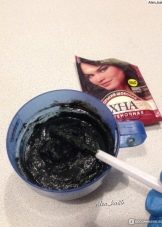Does henna paint over gray hair or not?

Henna is a natural dye that only has a beneficial effect on the scalp and hair. But despite the fact that after dyeing the hair acquires a bright shade, with gray hair everything may not be so simple.

Advantages and disadvantages
Henna is able to paint over gray hair with high quality, but not in all cases. It is ideal for those women who do not want to resort to the use of chemicals.
The natural powder can be used on both dark and blonde hair. The result will largely depend on the natural shade. Painting is done by yourself at home, since it is very easy to apply the product.
There are several types of henna: it differs among themselves not only in the place where it grows, but also in possible shades, pigment intensity, resistance on the hair. There is an Iranian, Indian product. This paint does not contain any chemicals or other synthetic ingredients. It is made by hand by collecting the leaves of special plants, then drying them and grinding them into powder.
A woman who uses henna to dye her gray hair may find that the health of her hair improves after dyeing. If necessary, add other natural ingredients to the mixture that allow you to change the shade.



Usually, the fair sex, who use henna for gray hair, can regulate the strength of the color themselves. Unfortunately, henna sometimes looks unnatural on gray hair, and this is its main drawback. This result can be related to the color or quality of the dye or hair type.Some people think that when using henna, it is necessary to paint over the curls several times in order to achieve the desired result, but in reality it is not so simple. Most women underexpose the composition, wash it off too quickly or dry it out, which should not be, because then it does not paint over gray hair.
Of the main advantages, it is necessary to highlight a number of characteristics.
- Henna dyeing has many advantages over chemical dyeing. It gives a wonderful color to the hair, fills it with strength, mineral complex and vitamins, as a result, a long-awaited shine appears, the structure changes for the better.
- Henna makes hair strong, thick, does not damage or break it.
- It is one of the best conditioners for beautiful looking hair and helps to increase volume.
- It is difficult to imagine a better dandruff remedy. Henna has a positive effect not only on the hair, but also on the scalp. This natural dye solves the problem of hair loss. You can mix the powder with mustard oil and apply to the curls for one hour.



Despite the fact that there are few significant drawbacks to the natural dye, they still exist.
- There is never a guarantee of what color you end up with. There are many factors that affect the result, including when the crop was harvested, weather conditions and where the plant is cultivated. The storage conditions of henna also affect the staining result.
- If desired, then it is difficult to extract the natural coloring pigment from the hair, you have to wait until they grow back and just cut them off.
- Some girls report dryness after using henna, but this is rare. If the hair is naturally dry, then using the herb makes it even drier, so it is best to apply the composition to well-moisturized hair.
- Occasionally, the plant can cause an allergic reaction when it comes into contact with the scalp, although this is not often the case.
- After using henna-based paint, curls can become straight, that is, attractive curls are straightened.

Which henna is better to use?
If there is no need to dye your hair, but you need to treat it, then you can use colorless henna. It does not affect the shade in any way, but it will help strengthen the hair follicle, get rid of split ends and dandruff, and make the curls stronger.
Colorless is made from crushed Indian lavsan leaves. There is no coloring pigment in this plant, so you can safely add the powder to the masks so that the curls become shiny and grow faster.
The most popular is colored henna, which is even cheaper than the previous version. She not only has healing properties, but also colors the curls in different shades of red and copper.
There is another third option on the market - lightening. Its peculiarity is that the curls after dyeing become lighter in several tones. An excellent solution for blondes, but this powder can only be used in combination with hair oil.



Staining technique
Henna is applied on light brown hair, brown, black and even blondes. When applied correctly, it produces a beautiful brown color. A product that produces a red sheen works best on gray hair as it provides a reliable effect on the hair structure. When applied, the mixture will give the curls a natural reddish tint with the addition of a sunny orange tint. The staining technique is simple and straightforward, so the paint is often used independently at home. It includes a series of sequential steps.
- At the first stage, you will need to mix henna with water so that it turns into a paste. It is best to keep the liquid slightly warm to release the color pigment more quickly. The product is supplied in packages, their quantity depends on the type of hair. With shoulder length, one bag is enough, if the curls are longer, it is better to buy two packs or even three.
- Henna easily stains any surface, so it's best to wear old clothes and cover the floor.
- Add small amounts of water to the powder, stirring well. There is no exact amount of liquid, you just need to achieve the consistency of thick sour cream.
- Before applying, it is advisable to lubricate the skin around the hairline with oil or cream, then the pigment will not be absorbed, and you will not have to wipe the henna from the forehead and ears. Always wear rubber gloves on your hands.
- Before painting, it is imperative to wash and dry the curls. They don't use a hairdryer, you can just blot them well with a towel. The dye will fit better on slightly damp hair.
- You will need to divide the curls into parts so that it is more convenient to paint over them. The mixture is applied evenly along the entire length, the already painted ones can be hooked with clamps so that they do not interfere.
- The mixture is left on the head for one to two hours, or longer if you want to achieve a more intense color. The head must be first covered with polyethylene, then wrapped in a towel. Only in this way the mixture will not dry out, and throughout the entire time the pigment will be absorbed into the hair.
- After that, the hair is simply rinsed under running water without using shampoo. It is not necessary to apply it and then for several days.




Advice
- it is better to apply the powder to damp hair, it is advisable to add oil to the mixture, since henna dries the curls, you can first apply argan to the curls;
- adding sugar makes the paste smoother;
- in order to get a deeper, richer shade, it is worth using fresh powder;
- after painting it is worth using conditioner.



What can you add?
In the traditional version, henna gives a very beautiful, red-orange hue, but not everyone likes it or suits it, so women have learned to change the tone using other natural additives. To prevent the paint from overdrying the already naturally dry curls, a few drops of rosemary or clove oil are poured into it, lemon oil gives a good shine. To help the coloring pigment stick better on dark gray hair, it is a good idea to use cocoa.
Egyptians achieved a dark, deep shade with the help of high-quality steep tea leaves, which were poured in powder instead of plain water. To improve the healing effect, you can take a decoction of nettle.
The more coffee there is in henna, the more chocolatey the shade on the hair will turn out.
A chestnut color can be achieved with cinnamon and cloves. But red wine makes the color more intense and not red, but fiery. Saffron can be used for the same effect.
On the contrary, to smooth out the intensity of the color, lemon juice and an egg have been used since ancient times, which were added to henna powder.



Follow-up care
Even henna-dyed hair requires follow-up care. First of all, you will need to regularly tint the roots, since gray hair will be visible when the root zone grows. The staining process is no different from the standard procedure, just the first paint should be applied to the roots, only after that to the rest.
Be sure to use moisturizing masks in the future, as they will make the curls softer. Sometimes after using henna, they become dry, tough, the thing is that the grass dries out the curls.
For conditioning, soak henna powder overnight in freshly brewed black tea. Before use, add 1 tbsp. l. oil or ½ egg and apply to hair. Leave for an hour, then wash off.
If dandruff occurs, using colorless henna powder once a week will help get rid of the problem. You will need to soak 2 tsp. fenugreek seeds in 4 tbsp. l. cottage cheese for the night, chop the next morning, add 2 tbsp. l. henna and 1 tbsp. l. lemon juice. The mixture is applied to the scalp and washed off after 45 minutes.


For a master class on dyeing hair with henna, see the next video.








